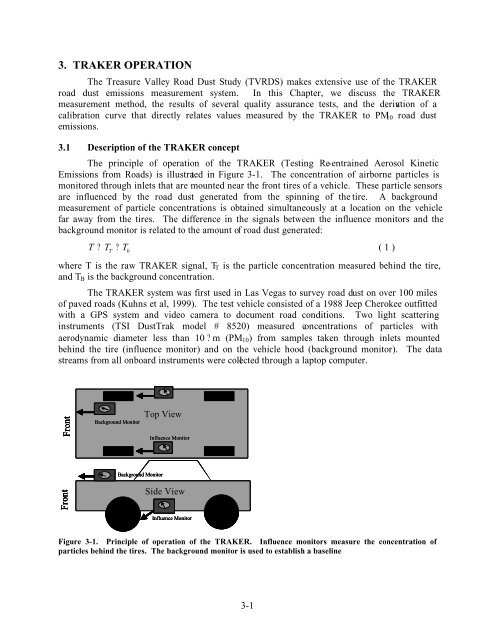treasure valley road dust study: final report - ResearchGate
treasure valley road dust study: final report - ResearchGate
treasure valley road dust study: final report - ResearchGate
You also want an ePaper? Increase the reach of your titles
YUMPU automatically turns print PDFs into web optimized ePapers that Google loves.
3. TRAKER OPERATION<br />
The Treasure Valley Road Dust Study (TVRDS) makes extensive use of the TRAKER<br />
<strong>road</strong> <strong>dust</strong> emissions measurement system. In this Chapter, we discuss the TRAKER<br />
measurement method, the results of several quality assurance tests, and the derivation of a<br />
calibration curve that directly relates values measured by the TRAKER to PM 10 <strong>road</strong> <strong>dust</strong><br />
emissions.<br />
3.1 Description of the TRAKER concept<br />
The principle of operation of the TRAKER (Testing Re-entrained Aerosol Kinetic<br />
Emissions from Roads) is illustrated in Figure 3-1. The concentration of airborne particles is<br />
monitored through inlets that are mounted near the front tires of a vehicle. These particle sensors<br />
are influenced by the <strong>road</strong> <strong>dust</strong> generated from the spinning of the tire. A background<br />
measurement of particle concentrations is obtained simultaneously at a location on the vehicle<br />
far away from the tires. The difference in the signals between the influence monitors and the<br />
background monitor is related to the amount of <strong>road</strong> <strong>dust</strong> generated:<br />
T ? T T<br />
? T b<br />
( 1 )<br />
where T is the raw TRAKER signal, T T is the particle concentration measured behind the tire,<br />
and T B is the background concentration.<br />
The TRAKER system was first used in Las Vegas to survey <strong>road</strong> <strong>dust</strong> on over 100 miles<br />
of paved <strong>road</strong>s (Kuhns et al, 1999). The test vehicle consisted of a 1988 Jeep Cherokee outfitted<br />
with a GPS system and video camera to document <strong>road</strong> conditions. Two light scattering<br />
instruments (TSI DustTrak model # 8520) measured concentrations of particles with<br />
aerodynamic diameter less than 10 ?m (PM 10 ) from samples taken through inlets mounted<br />
behind the tire (influence monitor) and on the vehicle hood (background monitor). The data<br />
streams from all onboard instruments were collected through a laptop computer.<br />
Front<br />
Background Monitor<br />
Top View<br />
Top View<br />
Influence Monitor<br />
Background Monitor<br />
Front<br />
Side View<br />
Influence Monitor<br />
Figure 3-1. Principle of operation of the TRAKER. Influence monitors measure the concentration of<br />
particles behind the tires. The background monitor is used to establish a baseline<br />
3-1
















